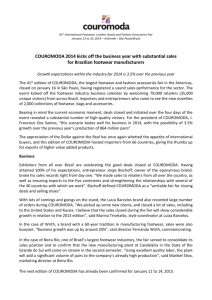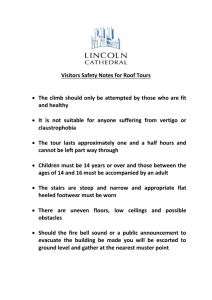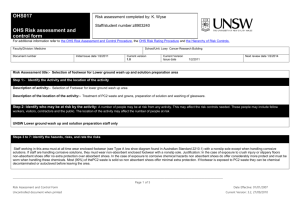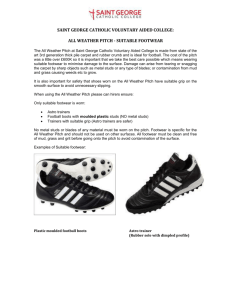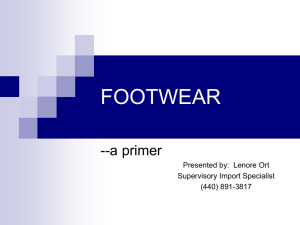ProtectiveWinterFoot.. - UD E
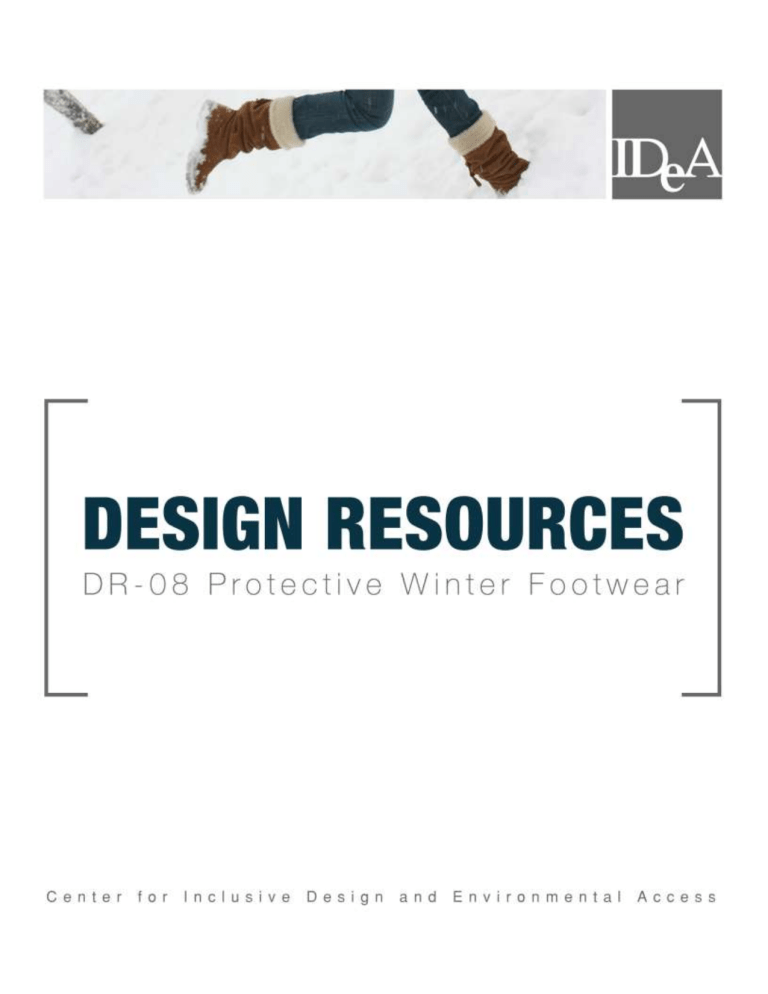
Protective Winter Footwear
Jennifer Hsu, PhD 1,2 , Yue Li, PhD 1 , Geoff Fernie, BSc, PhD, MIMechE, CEng, PEng, CCE 1,2
1 Toronto Rehabilitation Institute; 2 University of Toronto
Issue and Its Importance to Universal Design and to Stakeholders
The goals of universal design centre upon increasing usability, safety, and health through designs that support physical and social activities and social participation. During the winter season, there are great challenges to mobility that arise from barriers and hazardous conditions due to cold temperatures and precipitation. These conditions prevent many people from regular activity and participation and compromise their health and safety during outdoor excursions.
The design of winter footwear is an important element in protecting users and allowing for safer mobility. Users have many concerns when it comes to the footwear they choose to use in winter conditions. Important factors for the design of footwear include comfort, thermal protection, cost, and aesthetics. Two key aspects of winter footwear design that relate to universal design are slip resistance and usability. Because of the unpredictable and often treacherous conditions that can arise from winter weather, winter footwear should provide stability against slips and falls. The prevention of slips and falls is of particular importance for outdoor workers and older adults as they are at higher risk of injury. Lost-time and fractures incurred due to outdoor accidents are a major strain on their personal well-being, their families, as well as on worker’s compensation and healthcare systems.
Usability is also a crucial aspect of the design of winter footwear for those with functional limitations. In winter, pedestrians need to don layers of garments to protect themselves from excess cold exposure. For people with limited muscle strength and impaired joint mobility, the act of preparing for winter outings can be exhausting and prevent them from leaving their homes for months at a time. Users who do not have the dexterity, balance, and postural control required for the conventional donning of footwear require designs that better suit their needs.
Existing Research/Evidence
Slips and falls: Outdoor occupational workers and older age community-dwellers are particularly vulnerable to injuries due to outdoor falls in winter. In a study of 96 communitydwellers between 60-88 years of age, 52% experienced one or more falls during a one-year period. Most of these falls occurred while walking on level or uneven surfaces with men falling most often in winter (Berg et al., 1997). An analysis of emergency room admissions of older workers also indicated that the most common causes for hospitalization were fractures or dislocations due to same-level falls with slips on ice and snow being the leading cause of falls in men (Layne & Landen, 1997). Two-thirds of slips leading to falls at work, home, and during leisure activities in the Nordic countries have been estimated to have occurred on pavement or other surfaces covered by ice or snow (Gronqvist & Hirvonen, 1995).
The vast majority of slip and fall research concentrates on the prevention of indoor accidents where the surfaces can be relatively uniform and the environment can be controlled. Few studies have focused on the outdoor environment which, particularly in winter, is far less controllable and predictable. Human factors, gait biomechanics, extrinsic environmental
factors, and footwear all contribute to increasing slip and fall incidents in the winter (Gao &
Abeysekera, 1995). Strong evidence suggests that footwear is a key factor in slips and falls and that the design and performance of winter footwear require more attention and research in order to better protect at-risk populations (Gronqvist & Hirvonen, 1995; Bentley & Haslam,
1998).
Winter footwear for older pedestrians: Ability to maintain and recover balance declines with age due to sensory degradation and the deterioration of muscular strength (Lockhart et al.,
2003; Pavol et al., 2002). By identifying the types and characteristics of footwear worn at the time of falls, researchers have linked potentially hazardous footwear to accidental fall events
(Menz & Lord, 1999). The absence of a method for fixing the shoe to the foot (such as laces or
Velcro), excessively flexible heels, or excessively flexible soles were the most common characteristics of footwear worn at the time of falls leading to hip fractures (Sherrington &
Menz, 2003). Studies have shown that elevated heel heights and soft soles impaired balance while high collars and hard soles improved balance (Menz et al., 2006; Menant et al., 2008).
Indoor slip resistance tests have also shown that heel geometries have the greatest influence on slip resistance and most casual shoes perform sub-optimally on wet surfaces (Menz et al., 2001).
Slip-resistance is a priority outdoors in winter because surfaces become snowy, wet, and icy underfoot. For all pedestrians, but particularly for older populations, designs of anti-slip footwear and footwear devices simply provide inadequate slip resistance in winter conditions
(Bjornstig et al., 1997). Additional research is necessary to develop footwear capable of ensuring that the coefficient of friction (COF) can sufficiently counteract the critical forces at heel-strike and toe-off between the shoe and various wintry surfaces to mitigate slips (Abeysekera, 2001).
Furthermore despite many efforts to standardize slip-resistance measurement, there is no gold standard for the measurement of slipperiness even on indoor surfaces and variability of outdoor contaminants and surfaces means that designing measures and devices for them are even more difficult (Gronqvist & Hirvinen, 1995; Aschan et al., 2009; Beschorner et al., 2008; Redfern &
Bidanda, 1994).
Beyond slip-resistance, the fit of footwear, the thermal and moisture protection, and effects on callus formation, foot posture, and plantar pressure distribution have been and continue to be the focus of many research efforts (Kuklane, 2004; Kuklane, 2009; Perry et al., 2000; Jordan &
Bartlett, 1995; Jordan & Bartlett, 1994). However, none of these properties are of importance if the users are physically unable to don the footwear in the first place.
For older adults, another important aspect in winter footwear design is the ease with which footwear can be put on and taken off. Along with the threat of potentially unsafe conditions, difficult footwear application in conjunction with the application of other winter garments often deter older pedestrians from leaving the home in winter, diminishing their levels of activity (Row et al., 2004). Fixation methods and the stiffness of shoe and boot uppers impact the ability of people who have functional limitations to don and doff their footwear (Dunne et al., 1993).
While this is recognized as being important in designing footwear and sturdy shoes for older users and users with varying degrees of functional limitations, it has largely been neglected by researchers. Even formal assessments of footwear have neglected to include usability as a criterion of effective footwear (Menz & Sherrington, 2000).
Footwear for outdoor occupational workers: It is widely accepted that appropriate footwear is necessary to reduce the rates of slips and falls where outdoor accidents occur frequently. A study of four groups of outdoor worker organizations: a military regiment, mining company, construction company, and newspaper delivery service, found that groups that were provided professional footwear showed lower risks of slips and falls (Gao et al., 2008). Postal workers, for example, have a particularly vested interest in the effectiveness of winter footwear. Their jobs require that they walk in all types of weather conditions, usually in the early hours of the morning when falls are most prevalent, while performing their duties under load and timepressures (Bentley & Haslam, 2001). An analysis of 1734 fall cases during mail delivery conducted in the United Kingdom in 1998 showed that falls were most commonly initiated with slips on snow, ice, and grass, and trips most often involving uneven pavement, obstacles, and curbs also frequently led to falls (Bentley & Haslam, 1998). Poor slip-resistance from footwear was further identified as a key risk factor leading to slips, trips and falls during mail delivery
(Bentley & Haslam, 2001).
Studies of winter footwear and footwear devices: Over the last decade, advances in materials science and footwear designs have led to the introduction of new footwear and anti-slip devices in the market. In general, studies conclude that the available devices are inadequate in terms of outdoor safety in winter. Gao et al. (2004) tested the slip resistance properties of footwear soling materials on ice and concluded that while polyurethane soling, commonly used for winter boots, has demonstrated higher COF values than synthetic, nitrile, and natural rubbers on wet and lubricated floors, it does not perform significantly better on ice and thus may not provide sufficient slip resistance on ice (Gao et al., 2004). In another study of 49 types of footwear on wet and dry ice, it was found that none of the polyurethane and thermoset plastic materials improved COF on wet ice (Gronqvist & Hirvonen, 1995). Flat cleats with the largest possible apparent contact area resulted in the highest friction readings on dry ice and sharp cleats with very hard heel materials provided the highest friction on wet ice due to the formation of scratches (Gronqvist & Hirvonen, 1995). A 2008 study using a portable device for measuring pedestrian slip resistance by simulating heel contact found that on very slippery icy surfaces no treaded footwear provided enough grip (Aschan et al., 2009). Because of the difficulty in measuring COF and the ranging values measured from various test devices, there are only general guidelines for minimum requirements; on dry ramps the accepted minimum is 0.5. In icy conditions however, friction values fall below 0.3 thus strongly warranting the need for improved footwear outsole designs (Bergstrom et al., 2003).
Gait stabilizing devices for winter, such as those in Figure 1 have been developed to specifically
increase slip resistance under icy conditions. One such device is the Yaktrax walker which consists of bands of steel coil that conform to the length and width of shoes and boots (Figure 1-
B). While studies have shown that these devices are effective on snow-covered surfaces they can be a hazard if used incorrectly indoors or down dry, hard slopes (McKiernan, 2005). The consequences of wearing anti-slip devices with metal studs or coils on slopes and on non-ice surfaces is a major concern, as transitions between slopes, slippery, and non-slippery surfaces occur routinely throughout most pedestrian routes in winter.
A) B) C) D)
Figure 1 – A) This popular type of boot for postal workers is polyurethane-soled with leather uppers (example from Bates Footwear, a distributor of postal uniforms); B) The Yaktrax Walker consists of steel coiled elastics that fit over winter boots or shoes; C) Rough grips fit over winter shoes and boots and feature bands of sandpaper-like aluminum oxide mounted onto rubber
(Grips-Lite by All-Traction Footwear); D) Crampons (or ice cleats, or studded grips) fit over winter boots or shoes and come with metal studs that are partially embedded in rubber. This example uses 16 tungsten carbide studs (Altragrips-Lite by All-Traction Footwear).
Design Guidelines
Results gleaned from the literature form strong starting points on which to develop guidelines for the design of winter footwear and anti-slip devices that do not yet exist. Appropriate selection of footwear designs for indoor occupational workers are recognized as an important measure for preventing slips and falls in indoor workplaces (Maynard, 2002). The Shoe and
Allied Trade Research Association has developed guidelines for slip-resistant shoe sole design that recommends cross-hatched designs, tread patterns over the entire sold and heel, flat and flexible soles, and square heel breasts (Wilson, 1990).
The ISO standards applicable to footwear and foot protection are covered by the technical committee TC 216 and technical report 94/SC 3, respectively. ISO standards have been developed for testing the slip resistance of safety, protective, and occupational footwear, however these standards do not apply to special purpose footwear that contain spikes or metal studs (ISO 13287:2006). In fact, standardizing the measure slip resistance has proven to be an ongoing challenge and has been in progress by the ISO standardizing committee on foot protection for nearly two decades. Even on indoor surfaces developing reproducible measures of slip resistance to predict and prevent accidents has proven to be a great challenge that is further amplified when a contaminant such as spilt oil is involved (Jung & Fischer, 1993).
Outdoors, especially with ice and snow, because environmental factors such as the sole, floor, and contaminants, as well as biomechanical factors such as the speed, angle, and magnitude of the applied force, make taking meaningful and reproducible measurements difficult (Redfern &
Bidanda, 1994).
Summary of Related New Research Accomplished by RERC-UD
Two ongoing projects are underway at the Toronto Rehabilitation Institute to address the issues of slip biomechanics of winter footwear and the ease of donning and doffing winter footwear in populations with functional limitations.
Winter footwear on slopes and transitions for postal workers: A study of the biomechanics and usability of winter footwear and anti-slip devices used by Canada Post delivery personnel is underway. There are two major components of this project. First, through semi-structured interviews, the aim is to understand issues related to the use of protective winter footwear during the delivery of mail. Because postal workers encounter unpredictable conditions, such as inclines and transitions between slippery and non slip surfaces on a daily basis, it is necessary to determine how various designs impact their needs. The second major objective is to determine types of footwear that both effective and ineffective on winter surfaces by analyzing natural gait and slip-recovery on inclined, dry, and icy surfaces. In this way, recommendations for effective
alternatives to protect postal workers can be made along with development of appropriate design criteria for improving winter footwear in the future.
Winter footwear usability: A qualitative study is underway with the purpose of gaining a better understanding of the challenges that people who have various functional limitations experience in the application of footwear. One-on-one interviews are being conducted with users who have musculoskeletal impairments resulting from such conditions and events as stroke, cancer, osteoarthritis, and multiple sclerosis. These participants are helping researchers understand both the impact that winter and various footwear and footwear devices have on their daily experience as well as how their physical limitations influence their ability to put on and remove winter footwear. The end goal of this work is to develop winter footwear designs that such populations are able to use with minimal effort and without compromising other design considerations necessary for protective winter footwear.
Research Needs (What still needs to be done)
While the primary focus remains on usability and slip resistance, the next step is to improve guidelines for the thermal insulation of footwear. Under current ISO standards, even sandals and mesh shoes are considered cold protective (Kuklane et al., 2008). By improving design guidelines for slip-resistance, usability, and thermal protection, and also incorporating existing biomechanics research concerning the design of insole and outsole flexibility and pressure distribution, winter footwear designs will emerge that appropriately target both outdoor occupational workers and users with functional limitations, thus fulfilling an important objective of universal design.
Acknowledgements
This paper was developed in part with funding from the National Institute on Disability and
Rehabilitation Research (NIDRR), U.S. Department of Education, through the Rehabilitation
Engineering Research Center on Universal Design and the Built Environment (RERC-UD), a partnership between the Center for Inclusive Design and Environmental Access (IDeA) and the
Ontario Rehabilitation Technology Consortium (ORTC).
References
Abeysekera J. The identification of factors in the systematic evaluation of slip prevention on icy surfaces. International Journal of Industrial Ergonomics. 2001 Jan 1;28(5):313.
Aschan C, Hirvonen M, Rajamäki E, Mannelin T, Ruotsalainen J, Ruuhela R. Performance of slippery and slip-resistant footwear in different wintry weather conditions measured in situ.
Safety Science. 2009 Oct;47(8):1195-1200.
Bentley TA, Haslam RA. Slip, trip and fall accidents occurring during the delivery of mail.
Ergonomics. 1998 Dec;41(12):1859-1872.
Bentley TA, Haslam RA. Identification of risk factors and countermeasures for slip, trip and fall accidents during the delivery of mail. Applied Ergonomics. 2001;32(2):127-134.
Berg WP, Alessio HM, Mills EM. Circumstances and consequences of falls in independent community-dwelling older adults. Age and Ageing. 1997 Jul;26:261-8.
Bergstrom A, Astrom H, Magnusson R. Friction measurement on cycleways using a portable friction tester. Journal of Cold Regions Engineering. 2003 Mar;17(1):37-57.
Beschorner KE, Redfern MS, Lovell MR. Shoe-floor frictional properties for varying sliding speed, pressure and contaminant. 2007 Proceedings of the ASME/STLE International Joint Tribology
Conference. 2008;PART B:961-963.
Björnstig U, Björnstig J, Dahlgren A. Slipping on ice and snow--elderly women and young men are typical victims. Accident Analysis & Prevention. 1997 Mar;29(2):211-215.
Dunne R, Bergman A, Rogers L, Inglin B, Rivara F. Elderly persons attitudes towards footwear - a factor in preventing falls. Public Health Reports. 1993 Apr;108(2):245-248.
Gao C, Abeysekera J. A systems perspective of slip and fall accidents on icy and snowy surfaces.
Ergonomics. 2004;47(2004):573-598.
Gao C, Abeysekera J, Hirvonen M, Grönqvist R. Slip resistant properties of footwear on ice.
Ergonomics. 2004 May 15;47(6):710-6.
Gao C, Holmer I, Abeysekera J. Slips and falls in a cold climate: Underfoot surface, footwear design and worker preferences for preventive measures. Applied Ergonomics. 2008;39(3):385-
391.
Grönqvist R, Hirvonen M. Slipperiness of footwear and mechanisms of walking friction on icy surfaces. International Journal of Industrial Ergonomics. 1995 Sep;16(3):191-200.
Jordan C, Bartlett R. Relationship between plantar and dorsal pressure distribution and perception of comfort in casual footwear. Gait and Posture. 1994;2(4):251-251.
Jordan C, Bartlett R. Pressure distribution and perceived comfort in casual footwear. Gait &
Posture. 1995;3(4):215-220.
Jung K, Fischer A. An ISO test method for determining slip resistance of footwear :
Determination of its precision. Safety Science. 1993 Apr;16(2):115-127.
Kuklane K. The use of footwear insulation values measured on a thermal foot model.
International Journal of Occupational Safety and Ergonomics. 2004;10(1):79-86.
Kuklane K, Ueno S, Sawada S, Holmer I. Testing cold protection according to EN ISO 20344: is there any professional footwear that does not pass? Ann Occup Hyg. 2008 Nov 14;:men074.
Kuklane K. Protection of feet in cold exposure. Industrial Health. 2009;47(3):242-253.
Layne LA, Landen DD. A descriptive analysis of nonfatal occupational injuries to older workers, using a national probability sample of hospital emergency departments. Journal of Occupational and Environmental Medicine[Baltimore]. 1997;39(9):855-865.
Lockhart TE, Woldstad JC, Smith JL. Effects of age-related gait changes on the biomechanics of slips and falls. Ergonomics. 2003;46(12):1136-1160.
Maynard WS. Tribology: Preventing slips and falls in the workplace. Occupational Health &
Safety[Waco]. 2002;71(9):134-139.
McKiernan FE. A simple gait-stabilizing device reduces outdoor falls and nonserious injurious falls in fall-prone older people during the winter. Journal of the American Geriatrics Society.
2005;53(6):943-947.
Menant J, Steele J, Menz H, Munro B, Lord S. Effects of footwear features on balance and stepping in older people. Gerontology. 2008;54(1):18-23.
Menz H, Lord S. Footwear and postural stability in older people. Journal of the American
Podiatric Medical Association. 1999;89(7):346-357.
Menz H, Lord S, McIntosh A. Slip resistance of casual footwear: Implications for falls in older adults. Gerontology. 2001;47(3):145-149.
Menz H, Morris M, Lord S. Footwear characteristics and risk of indoor and outdoor falls in older people. Gerontology. 2006;52(3):174-180.
Menz H, Sherrington C. The Footwear Assessment Form: a reliable clinical tool to assess footwear characteristics of relevance to postural stability in older adults. Clinical Rehabilitation.
2000 Dec;14(6):657-664.
Pavol MJ, Runtz EF, Edwards BJ, Pai Y. Age influences the outcome of a slipping perturbation during initial but not repeated exposures. The journals of gerontology. Series A. 2002
Aug;57(8):M496-503.
Perry S, McIlroy W, Maki B. The role of plantar cutaneous mechanoreceptors in the control of compensatory stepping reactions evoked by unpredictable, multi-directional perturbation. Brain
Research. 2000 Sep 22;877(2):401-406.
Redfern MS, Bidanda B. Slip resistance of the shoe-floor interface under biomechanicallyrelevant conditions. Ergonomics. Vol. 37. 1994;(3):511-524.
Row B, Paul J, Fernie G. What is keeping older adults shut-in during the winter? The
Gerontologist. 2004 Oct;44(1):187.
Sherrington C, Menz H. An evaluation of footwear worn at the time of fall-related hip fracture.
Age and Ageing. 2003;32(3):310-314.
Wilson MP. Development of SATRA slip test and tread pattern design guidelines. ASTM Special
Technical Publication. 1990;(1103):113-123.
